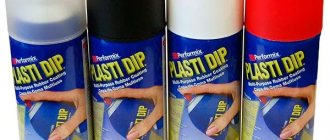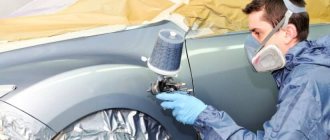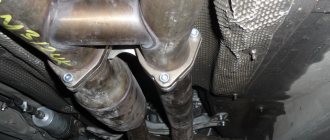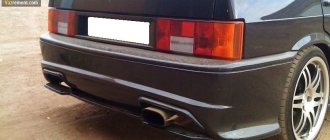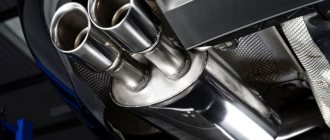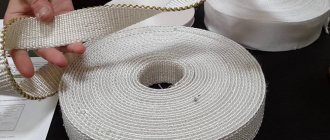Car painting
Drivers often ask the question of how to paint a car muffler against corrosion so that it doesn’t rust, looks good and lasts a long time.
Any metal can corrode. Rust is a natural process that occurs during oxidation. Corrosion on the muffler, car fenders, and other parts is a widespread phenomenon.
The main causes of muffler corrosion are:
- high temperature of exhaust gases in the middle of the part;
- constant temperature difference both inside and outside the muffler;
- condensation that accumulates on its inner walls;
- external factors: water, stones, abrasive materials, road salt.
Note!
Inside, the absorber consists of 2 or 3 chambers. This part absorbs part of the exhaust gases and reduces engine noise. For sound insulation, non-flammable materials are used: mineral or metal wool, metal shavings.
Since parts from any manufacturer are susceptible to corrosion, the question arises of how to paint a car muffler so that it does not rust.
To protect the exhaust system elements, they must be treated with anti-corrosion materials. Silicone enamels and heat-resistant varnishes cope with this function. There are both domestic and foreign paint and varnish materials on the car market.
You need to select paintwork materials according to the following parameters:
- Heat resistance, the higher the better. The engine and combustion products operate at elevated temperatures, which can reach up to 600-700 degrees. Since the muffler is an external part of the car, it is subject to rapid cooling and low temperatures, for example in winter. Therefore, the temperature scale should have a range from -35 to +600 degrees.
- Anti-corrosion.
- Waterproof.
- Painting properties: uniform structure, color saturation, drying speed.
Interesting!
Milton Reeves created a muffler for the internal combustion engine back in 1897.
Paint varnish is sold in aerosol or liquid form.
Silicone-based enamel has proven itself. Its advantages:
- resistance to mechanical damage;
- does not require preliminary priming;
- applied in two layers;
- Final drying is important, as well as inter-layer drying, which is done with a hair dryer.
Manufacturers of coatings for surfaces that are exposed to high temperatures:
- Chameleon:
- Tikkurila;
- Nordix;
- Kudo.
Now service station workers offer to paint the car muffler silver or black. These two shades can withstand short-term temperature heating up to +600 degrees, long-term up to +400°. Other colors can withstand less high temperatures. In addition, gray and black are the most standard colors for painting a muffler. This is due to the location where the part is attached. If you want to stand out, painting it in other colors is possible.
The muffler can only be painted from the outside. Craftsmen offer the “old-fashioned method” of cleaning the muffler tank. To prepare the mixture you will need 1 kg of graphite lubricant, 1 liter of solvent. This solution is poured into the muffler on one side, and the other hole is also closed. With this mixture, the part should stand for one day. During this time, the solvent will evaporate, but the lubricant will remain.
In order to paint the muffler against corrosion yourself, you need to take several steps.
- Wash with gasoline or white spirit.
- Remove rust and old paint with medium-hard sandpaper. To clean the elbow and welding seams, use a wire brush.
- The prepared surface must be degreased with acetone.
- Small holes should be filled with putty.
The system is now prepared for the next procedure. It remains to decide how to paint the car muffler against corrosion with your own hands.
On a note!
Condensation accumulates in the muffler tank, which helps rust to corrode its inner surface. To avoid this, you need to drill a small hole in the back of it, at the bottom, through which water will escape and evaporate.
An important point is the correct, thorough work of removing old paint. Before you start painting, you need to choose a painting tool. It could be:
- brush;
- spray.
You need to work in protective gloves, a mask, goggles, and work clothes. When drying, the paint releases toxic compounds that can harm humans. Prolonged contact with silicone enamel has a negative effect on human mucous membranes.
Note!
If lead is present in the parts being processed, a heat gun cannot be used. When heated, harmful substances evaporate.
Muffler painting steps:
- The enamel is applied in a thin layer, avoiding smudges. It is important to paint quickly and carefully, apply strokes evenly. Smudges not only look unsightly, but also reduce the anti-corrosion properties of the enamel.
- The applied paint is allowed to dry completely. Heat-resistant material needs high temperatures, otherwise it will not harden. Therefore, the muffler is heated to 160-200 degrees, and dried for 15-20 minutes. The painting is repeated several times until the surface is completely dry.
- When painting with a spray gun, you must maintain the same distance to the muffler and do not change the angle of painting. The enamel should cover all edges of the part.
- The final stage: heat treatment, which is done using a heat gun or a hair dryer. This procedure hardens the enamel. If possible, hot air should be passed in both directions.
Note!
Enamel can be applied in a temperature range of -20...+40 degrees. The main condition for painting is a dry surface of the part.
Ways to combat muffler corrosion
Over time, every part of the car wears out and requires replacement. The muffler is no exception. The average “life” of this part of the exhaust system depends on the service life, the quality of the metal and the roads. And it does not depend in any way on the manufacturer and price. Original spare parts last 3-4 years, others 1-1.5, there are exceptions.
Ways to combat corrosion:
- installation of a stainless steel muffler;
- checking for rust every six months at a service station or independently;
- painting with heat-resistant varnishes.
Applying varnish to the muffler is a good way to prevent rust, which eats up the car.
The muffler is an important part of the vehicle exhaust system. It is designed to silently remove exhaust gases from the combustion chamber and ensure correct engine operation. Elements of the exhaust system must withstand large temperature changes, because during operation they heat up to several hundred degrees in seconds. The exhaust assembly is located under the car and is constantly exposed to moisture. Water and dampness have a negative effect on metal and cause rust. If the muffler is not protected from factors that destroy the metal coating, it will quickly wear out. The service life of the part is significantly reduced. The necessary measures to protect the integrity of the exhaust manifold were not taken in a timely manner? The unit will need repair or replacement soon. There are several ways to extend the life of a part. One of them is to coat it with a special anti-corrosion compound. Don’t know what to paint your car muffler to prevent it from rusting? Take advice from experts.
Causes of corrosion
Any metal can corrode. Rust is a natural process that occurs during oxidation. Corrosion on the muffler, car fenders, and other parts is a widespread phenomenon.
The main causes of muffler corrosion are:
Note!
Inside, the absorber consists of 2 or 3 chambers. This part absorbs part of the exhaust gases and reduces engine noise. For sound insulation, non-flammable materials are used: mineral or metal wool, metal shavings.
Since parts from any manufacturer are susceptible to corrosion, the question arises of how to paint a car muffler so that it does not rust.
Painting the muffler extends the service life of the part
Read further:
How to paint a metal stove in a bathhouse?
Properties of heat-resistant paint: advantages and scope, types of compositions and coating technology
Do-it-yourself technology for painting chimneys: choosing paint and step-by-step instructions for painting from different materials
Painting a barbecue: features of paint selection and application technique.
Fire retardant paint: principle of operation and scope of application, types of paint for metal and wood, the best manufacturers
Please note: Thickness gauge: description of the device, rules and procedure for use
The vehicle exhaust system operates under difficult conditions. And often individual elements of this system fail after the first 3-5 years of car operation. The main cause of breakdowns is corrosion. Read below about how to paint a car muffler to prevent it from rusting.
How to paint a car muffler
To protect the exhaust system elements, they must be treated with anti-corrosion materials. Silicone enamels and heat-resistant varnishes cope with this function. There are both domestic and foreign paint and varnish materials on the car market.
You need to select paintwork materials according to the following parameters:
Interesting!
Milton Reeves created a muffler for the internal combustion engine back in 1897.
Paint varnish is sold in aerosol or liquid form.
Silicone-based enamel has proven itself. Its advantages:
Manufacturers of coatings for surfaces that are exposed to high temperatures:
Now service station workers offer to paint the car muffler silver or black. These two shades can withstand short-term temperature heating up to +600 degrees, long-term up to +400°. Other colors can withstand less high temperatures. In addition, gray and black are the most standard colors for painting a muffler. This is due to the location where the part is attached. If you want to stand out, painting it in other colors is possible.
The muffler can only be painted from the outside. Craftsmen offer the “old-fashioned method” of cleaning the muffler tank. To prepare the mixture you will need 1 kg of graphite lubricant, 1 liter of solvent. This solution is poured into the muffler on one side, and the other hole is also closed. With this mixture, the part should stand for one day. During this time, the solvent will evaporate, but the lubricant will remain.
The muffler is painted with heat-resistant varnish
The muffler is painted with heat-resistant varnish
In general, I bought gas-69 not so long ago. He is many years old. Accordingly, there is a little rust, although the condition is excellent for its age. Question 1: Rust has grown, how to get rid of it and how to prevent it from growing again? Paint it and that's it? Question 2: I’ll remove rust on the plug, but how can I prevent it later? Do you need to cover it with something? Paint with something heat resistant.
loose rust necessarily requires stripping down to metal or stable rye, after which pickling with a converter, preferably one with zinc, then thorough repeated washing with water, drying, primer with a converter, then painting. When you treat a rye stain, expose the paint to an area one and a half times larger, usually this is the amount already affected by the rye along the perimeter. but she will still appear in this place, the question is how long you can delay this process..
The Glushak is rusting while the muffin is standing still without work, clean it with a metal brush and continue driving, it will burn and everything will be as it should. When it completely rots, you put in another plug. Painting an already rusty muffler is a no-brainer.
In general, I bought gas-69 not so long ago. He is many years old. Accordingly, there is a little rust, although the condition is excellent for its age. Question 1: Rust has grown, how to get rid of it and how to prevent it from growing again? Paint it and that's it? Question 2: I’ll remove rust on the plug, but how can I prevent it later? Do you need to cover it with something? Paint with something heat resistant.
The easiest way to deal with rust on a Glushak is to actually fight the Glushak itself. For the third time, my Glushak looked like this, it went off with a bang ;): https://www.a-stone.ru/other/glushak.jpg
I don’t know how the Glushak survives until it rusts :)))))
In general, I bought gas-69 not so long ago. He is many years old. Accordingly, there is a little rust, although the condition is excellent for its age. Question 1: Rust has grown, how to get rid of it and how to prevent it from growing again? Paint it and that's it? Question 2: I’ll remove rust on the plug, but how can I prevent it later? Do you need to cover it with something? Paint with something heat resistant.
You can extend the life of the muffler by covering it with heat-resistant paint. But not for long, because... As a result of temperature changes, the paint will fly off, as well as exposure to dirt, water, etc.
Painting a Glushak is something of a joke.
The army also paints grass noona;)
And the rust is very much from experience. It’s difficult to do well - after every winter (when parking on the street in Moscow) new old spots begin to come out.
Painting a Glushak is something of a joke.
The army also paints grass noona;)
And the rust is very much from experience. It’s difficult to do well - after every winter (when parking on the street in Moscow) new old spots begin to come out. Not really funny, the mufflers on foreign cars are painted. In the Southern Port they sell special heat-resistant paint. I buy it regularly (for work, not for muffler). But for UAZ, I agree, it’s useless. This is the second time that my muffler lasts for one year. Just replaced another one yesterday. Due to sloppy welding, the internal partition comes off, the muffler turns into a direct-flow muffler, and the outside is still almost like new. PS But actually, just for fun, you can paint it.
. PS But actually, just for fun, you can paint it. well, yes, in bloody color;)
If you drive decently, then there’s no point in painting it, but if it’s 4 hours a week, it won’t have time to burn in the parking lot!
How to paint a muffler yourself
In order to paint the muffler against corrosion yourself, you need to take several steps.
The system is now prepared for the next procedure. It remains to decide how to paint the car muffler against corrosion with your own hands.
On a note!
Condensation accumulates in the muffler tank, which helps rust to corrode its inner surface. To avoid this, you need to drill a small hole in the back of it, at the bottom, through which water will escape and evaporate.
An important point is the correct, thorough work of removing old paint. Before you start painting, you need to choose a painting tool. It could be:
You need to work in protective gloves, a mask, goggles, and work clothes. When drying, the paint releases toxic compounds that can harm humans. Prolonged contact with silicone enamel has a negative effect on human mucous membranes.
Note!
If lead is present in the parts being processed, a heat gun cannot be used. When heated, harmful substances evaporate.
Muffler painting steps:
Ways to combat muffler corrosion
Over time, every part of the car wears out and requires replacement. The muffler is no exception. The average “life” of this part of the exhaust system depends on the service life, the quality of the metal and the roads. And it does not depend in any way on the manufacturer and price. Original spare parts last 3-4 years, others 1-1.5, there are exceptions.
Ways to combat corrosion:
Applying varnish to the muffler is a good way to prevent rust, which eats up the car.
Source
The final stage of how to paint a car body in the garage with your own hands
If you are already familiar with the process of polishing a car body, then you know how important the final result is, because only it can bring positive emotions. In order for painting work to be carried out at a high level, it is necessary to select the correct spray gun nozzle, as well as the paint composition.
Preparing the paint
Automotive paints must meet the viscosity of 15-20 seconds. This parameter is measured with the simplest capillary viscometer, the cost of which is in the range of 300-600 rubles. The procedure is simple and is performed according to the following scheme:
- Close the outlet of the funnel with your finger and fill it with paint.
- At the same time, open the hole and start the stopwatch.
- Record the time it takes for all the paint to flow into the hole.
All measurements are made at a temperature of 20-22°C. Optimal viscosity values are indicated on the packaging. In the absence of a viscometer, the viscosity can be checked visually - the paint should flow from the rod at a speed of 3-4 drops per second.
Setting up the spray gun
Now we know how and with what to remove rust from a car and paint the body with primer. All that remains is to adjust the spray gun. When the paint viscosity is 20-22 seconds, install a 1.4-1.5 mm nozzle; at 30-35 seconds, a 1.6-1.8 mm nozzle is suitable.
When setting, the size of the surface to be painted is also taken into account. For example, to paint the pillars, you need to adjust the spray gun so that it produces a narrow stream of paint, and for the hood - a wide one. The air pressure is set within 2.5-3 Atm.
Car body painting process
The spray gun should be held at a level of 18-20 cm from the surface being treated. The equipment is directed perpendicular to the body, and the paint is applied in even stripes, overlapping 1/2 of the previous strip.
Experts determine another important parameter - the speed of movement of the hand with the spray gun; it should be 45-50 cm/s. In other words, one pass with the tool from one edge of the area to be painted to the other should take approximately 2 seconds. Naturally, this indicator is a recommendation; the main criterion is the thickness of the layer. Therefore, before you paint the car body with your own hands, it is recommended to test the process on some unnecessary surface.
The process starts from the highest point with a sequential transition to the lower sections. On average, three layers are applied, each of which should dry within 30-40 minutes. The final drying time is 25-30 hours at a temperature of at least 20°C. Next, all that remains is to remove the tape and paper that covered individual elements of the car from the paint, and polish it with polishing paste.
3 proven methods to protect the muffler from corrosion
The muffler is an important part of the vehicle exhaust system. It is designed to silently remove exhaust gases from the combustion chamber and ensure correct engine operation. Elements of the exhaust system must withstand large temperature changes, because during operation they heat up to several hundred degrees in seconds. The exhaust assembly is located under the car and is constantly exposed to moisture. Water and dampness have a negative effect on metal and cause rust. If the muffler is not protected from factors that destroy the metal coating, it will quickly wear out. The service life of the part is significantly reduced. The necessary measures to protect the integrity of the exhaust manifold were not taken in a timely manner? The unit will need repair or replacement soon. There are several ways to extend the life of a part. One of them is to coat it with a special anti-corrosion compound. Don’t know what to paint your car muffler to prevent it from rusting? Take advice from experts.
Is it allowed to paint the muffler on a car?
Whether to paint the exhaust pipe is up to you. The factory paint, which is mainly responsible for its presentable appearance, begins to lose its integrity soon after purchasing the car. In addition, scratches are possible already during installation, and welding work reduces the protective characteristics of the top layer.
Rusty car muffler
Although it is not covered with anything on the inside, when properly applied to protect the car muffler from corrosion on the outside, the paint still protects for some time, significantly extending the life of the part.
Choosing heat-resistant paint for a car muffler
Anti-corrosion muffler paint is commonly used in automobile manufacturing. It protects the metal from rust for some time. However, during operation of the exhaust system, the factory coating quickly burns, so the element needs to be painted again. How to treat a part to extend its service life? Since the exhaust manifold can heat up to 700-800 °C during vehicle operation, it needs to be painted only with paintwork that will ensure high thermal and corrosion resistance of the part. For these purposes, it is recommended to use heat-resistant silicone enamel. One-component paintwork materials are intended for application to surfaces that during operation are exposed to extremely low or high temperatures: from – 60 °C to + 600 °C. Painting the muffler with organic enamel containing silicon protects the part from corrosion and helps increase the service life of the exhaust manifold. The composition of paints and varnishes contains special additives, which ensure excellent painting and technological properties. There is no need to prime the surface to be treated before applying silicone enamel. The muffler coated with high-temperature paint is resistant to salt fog, gasoline, oils and moisture, and sudden changes in temperature. Enamel is well transported. During storage it does not lose its original properties. It can be easily applied to a previously prepared surface using a brush or roller, sprayed using pneumatic or airless spraying. It is not destroyed by exposure to high temperatures. The strength indicators of the exhaust manifold, on the contrary, are improving. It is possible to coat the muffler with silicone enamel even at subzero temperatures. The main condition is that the paint must be applied in several layers, each time after complete drying at a temperature of 160 to 200 ° C. A hair dryer or drying cabinet is suitable for heat treatment. Painting the muffler with heat-resistant paint is a process that requires following the instructions. If used incorrectly, paintwork materials will not provide the expected effect.
Painting options
The main task of paint for the exhaust system is to withstand high temperatures. Therefore, the only suitable option for painting the muffler is heat-resistant paints. In practice, two main options for exhaust pipe paints are most often used.
- Silicone heat-resistant paints. They are in demand among amateurs, as they do not require specific conditions or special skills from the car owner for application. Sold in both standard cans and aerosol cans. Resists high temperatures well. However, it has been noticed that the exhaust manifold painted with this paint will peel off quite quickly. And on colder elements remote from the engine, such as a resonator, catalyst or muffler itself, silicone paint holds up well.
- Powder heat-resistant paints. Typically used in industrial settings. Able to withstand higher temperatures than silicone options. However, they are more difficult to apply.
It is recommended to paint only new exhaust system elements. Surface painting of a used muffler, with signs of corrosion and especially without preliminary preparation, will not give a long-term result.
Where does corrosion occur?
Intensive corrosion of the car body begins from below. Rust prefers to appear on parts of the body exposed to paint, in areas that most often come into contact with moisture. These are the bottom, spoilers, wings, etc. Risk areas are considered to be
The underbody of the car, which bears the maximum load, requires close attention. All power units are concentrated under it, and therefore the bottom experiences the aggression of chemical agents and temperature changes. Outside - impacts from pebbles and crushed stone, ice build-ups in winter, tall grass or tough low bushes in summer - these factors tear off the protective layer of anti-corrosion, exposing the metal of the bottom to the destructive effects of moisture and dirt. Anti-icing chemicals containing salts and acids pose an increased danger to vehicles. To protect your car from rust, you need to eliminate the causes of metal corrosion.
Muffler painting instructions
Before painting a car muffler, to prevent the assembly from rusting, you must thoroughly clean the surface of the old coating. This is a mandatory stage on which the strength and reliability of the subsequent coating, effective protection against corrosion and wear depend. When painting the most important part of the exhaust system, special attention should be paid to the quality of its cleaning from rust, dirt and old coating. The heat-resistant composition ideally fits only on a well-prepared surface.
Preparation
For cleaning you can use: – a stiff brush with wire bristles; – chemical removers; – figured scraper; - heat gun. When using a brush with stiff wire bristles, rust can often be found under a layer of paint and dirt, the area of which must be additionally treated with epoxy putty. Chemical strippers can be used before applying heat-resistant (heat-resistant) spray paint to the muffler. These active substances are excellent for cleaning the surface of a part from old organic or water-soluble paints. They are applied in a thick, dense layer to the part. To do this, use a brush with natural bristles. Then the paint is removed using a spatula or wooden spatula. After this, the surface should be wiped dry with a clean rag or napkins. A shaped scraper is used when preparing an exhaust system element for painting. It's convenient to use. To achieve a perfectly smooth surface, it is necessary to sand using medium-grain sandpaper or a special machine. Heat-resistant spray paint for the muffler adheres well to a surface that has been cleaned of the old enamel layer using a heat gun. This tool must be used with extreme caution, observing fire safety regulations. To do this, it is recommended to place a piece of damp cloth under the part during heat treatment.
Important! A heat gun cannot be used if it is made with a large amount of lead. This chemical element evaporates when heated, so it can be harmful to health.
Painting
If you have already decided on how to paint the car muffler so that it does not rust, you can start painting. This stage has its own difficulties. During the process of painting the muffler, smudges often form. They can worsen the performance characteristics of the unit and do not look aesthetically pleasing at all. To prevent the formation of sagging, you must adhere to a simple technology: – the enamel must be applied in thin layers, each time after complete drying; – the spray gun should be held at the same distance from the surface; – do not move the sprayer at an angle or in an arc; – the sprayed substance should capture not only the edges of the part, but also extend beyond its boundaries; – each strip must be applied evenly to the previous painted areas.
Pay attention to: Painting wheels with powder paint: advantages of technology, step-by-step instructions for painting
Heat treatment
After coating, the surface needs additional heat treatment. The easiest way to do this is with a hair dryer. In order for a truly heat-resistant coating to form during the drying process, it is necessary to periodically pass hot air through the part in both directions. Some experts also advise pre-heating the outer part of the exhaust manifold. However, some motorists believe that this stage is not mandatory. According to them, the muffler heats up during the operation of the equipment, so it does not require additional calcination.
Muffler painting procedure - what are the advantages?
- Muffler painting procedure - what are the advantages?
- When does it become necessary to paint the muffler?
- What paint is suitable for painting a muffler?
- We prepare everything necessary for the painting process
- What you should pay special attention to when painting the muffler
The system of any car has a certain number of different mechanisms. Almost the main function is the presence of an exhaust system, or simply put, the exit of already processed gases from the combustion chamber, which is located in the engine. As you know, the operating temperature of all elements of the exhaust system changes not by tens, but by hundreds of degrees, so the muffler must be painted very competently.
- When does it become necessary to paint the muffler?
- What paint is suitable for painting a muffler?
- We prepare everything necessary for the painting process
- What you should pay special attention to when painting the muffler
In automotive production, such parts are treated with the simplest but high-quality anti-corrosion agents.
Such means are needed to very well protect the metal from damage from destructive corrosion, as well as from damage while driving a car, because when the engine is running, the coating on the muffler burns too quickly. There is another risk point, which is that while the car is moving, dirt and moisture may enter the exhaust system. Most often this happens while the car is moving, since the exhaust system elements are located under the bottom of the car. A very heated metal reacts to such factors more quickly than it does in a calm state. In addition, condensation may form in the muffler while the car’s engine is idling, or the car is warming up for a long period of time in the winter. And the presence of moisture, as we know, is an inevitable occurrence of corrosion.
When does it become necessary to paint the muffler?
Painting a car muffler is necessary not only to protect it well from corrosion, but also to completely prevent the fairly rapid aging of the metal, which begins under the strict influence of thermal shock.
The outer side of the muffler most often cools down under the influence of ambient temperature. The inside of the muffler may suffer due to the influence of hot exhaust gases on it. Sometimes a certain amount of condensation may fall in this part, which has a negative effect because it can form corrosion.
Due to the fact that there are quite a lot of reasons that have a very bad effect on the car, therefore, if the protection is poor, the muffler will not work for very long.
What paint is suitable for painting a muffler?
Painting the muffler will not be a waste of time and money if you use special heat-resistant paint.
When you choose what to paint the muffler with, you need to take into account the fact that this element of the system heats up to almost one hundred degrees, and the temperature of the collector can reach up to four hundred degrees. Painting the muffler based on silicone has worked quite well. This paint composition does not require preliminary priming of the surface, and it must be applied several times, the time between applying each layer should be about ten minutes. This application of paint will help you avoid smudges. When using the latest heat-resistant paints, it is necessary to bake it when applying it to the surface of the muffler. If this is not done, the paint will not harden, and the protective coating that is on the part can be very easily damaged when using metal wrenches during repairs or installation. To put it another way, painting the muffler consists of mandatory high-quality heat treatment. In order to achieve this, you can use a special drying cabinet, and you can also use a special hair dryer.
We prepare everything necessary for the painting process
When preparing for the painting process, the first step is to clean off the old paint from the muffler. If this is not done, the painting of the part will be of poor quality. In particular, it is very important to remove all accumulated corrosion and rust from the muffler.
There are several ways to remove such formations:
- the first thing you can do to remove such deposits is to use a fairly stiff brush with good quality wire bristles for cleaning. It happens that a spot of destructive corrosion may form on the muffler, then it must be treated with epoxy putty.
— the use of a simple scraper shows very good results. This tool is used during the preparation of various elements for the painting process. If you need to process a relief surface, you can use special shaped scrapers. And in order to speed up the processing process, you can use a special grinding machine.
— if you need to remove the old layer of paint from the muffler, you can use good chemical washers. They are very suitable for cleaning surfaces from various water-borne paints and organic compounds.
In order to properly clean a car muffler, an ordinary heat gun may be suitable for this task, but it must be used as carefully as possible. As soon as the paint on the muffler has blistered and peeled off, it must be carefully removed. This method is not suitable for elements that are made of material that contains a large amount of lead, because when heated, it may begin to evaporate, which is dangerous to your health.
How to protect your car from corrosion?
Puttying, priming and painting the body are carried out, first of all, to protect the car from rust. The paint coating prevents contact of the metal with the external environment. And only then is it an element of beauty and design.
But even the most professional painting is not able to protect the car from rust if the permanent place of residence is the street: an open parking lot, or a yard. In such conditions, even the paintwork wears out much faster than when the car is placed in a garage overnight - an enclosed space with ventilation and, if possible, heating. In addition to the conditions for storing the car, some measures are taken to increase resistance to corrosion.
After all, the thickness of the metal of the car body is less than 1 mm. And if you do not provide protection from moisture and corrosion, within a year, the rust will eat through the body of the car. The car becomes especially vulnerable to destruction in winter.
Drilling a hole
Under the influence of constant temperature changes, condensation constantly forms in the rear muffler reservoir, which also contributes to the appearance of rust spots.
Among other things, in the winter season, the accumulated liquid, the volume of which often exceeds 0.5 liters, leads to freezing of the muffler, as a result of which the car stops starting, and it becomes possible to start it only after thawing or heating.
And in order to avoid any of the listed complications, many car enthusiasts drill a hole in the tank of the smallest diameter that is possible.
This simple technique prevents internal accumulation of liquid, and therefore corrosion by freezing.
In addition, some modern car models have this hole by default, which means that before using the drill, you need to make sure that the rear reservoir of the installation has a solid bottom.
Body protection: galvanized, etc.
Protection of the body from corrosion begins during the production process. Recently, a number of enterprises producing cars have galvanized bodies with the sole purpose of slowing down the oxidation processes of iron.
Lamination
As mentioned above, body painting is also, first of all, an element of body protection against rust, and only then aesthetics and design. True, in recent years the quality of painting has improved; cars are not just painted, they are varnished and polished, and airbrushed designs are applied. And therefore the question arose about protecting the paintwork.
One of the methods of such protection is lamination, that is, gluing a transparent protective film. The polymer film has water-repellent properties and protects the body surface from minor scratches and rust. Thanks to the adhesive layer, it is easy to stick to the surface of the body. The film is especially effective for protecting critical areas.
Before lamination, the machine undergoes preparation - it is cleaned where necessary, rust, scratches and chips are removed, and unevenness in the paintwork is polished. Lamination can last 2-3 years, and then the film can be replaced with a new one.
Cathodic protection
This method is based on the physical and chemical properties of metals, and is not inferior in reliability to galvanizing. Such protection is provided by a compact device - a cathodic protection device (CCD). The device transfers a negative charge to the body, creating a galvanic connection between the body and a separate electrode. A metal that has acquired anodic properties loses its ability to oxidize. This method is quite simple, reliable, and protects hard-to-reach places, since the charge from the device is distributed over the metal surfaces of the machine.
Car fender protection
The wings of the car suffer from gravel, crushed stone, and lumps of dirt flying out from under the wheels. Then, if no action is taken, rust begins to eat into the damaged area of the metal. There is an additional way to protect your car fenders from corrosion. For many models, so-called plastic fenders have been developed. This tuning element takes on mechanical shocks, protecting the wing from damage. The inside of the metal must be protected with mastic.
Comprehensive measures will ensure complete protection against corrosion
It is recommended to carry out all the mentioned methods of protecting metal from corrosion in a complex, without relying on the absolute reliability of one of them. Even if, for example, the underbody is galvanized, the bitumen film will additionally protect it from stones and gravel falling into it. Lamination will protect the body from rust and mechanical damage.
In this case, cathodic protection of the metal from corrosion will not be superfluous. The lack of anti-corrosion protection shortens the life of a car, and thus protected and corrosion-resistant cars last much longer than their unprotected counterparts.
Source
Thermovarnish treatment
Another proven method of anti-corrosion protection of a muffler is to use a special thermovarnish. We are talking about a type of coating that is particularly resistant to high temperatures, preventing the appearance and further spread of rust spots.
At the same time, it is strongly recommended to use such a product even after drilling a hole in the muffler compartment, since the walls of the drilled hole are subject to corrosion much more than any other parts of the body, without galvanizing or any other protective coating.
If, by the time of treatment, the external elements have already undergone corrosive changes, then before applying the thermovarnish, an appropriate preparation procedure will have to be carried out.
To do this, it is recommended to use a special abrasive tool for cars - a brush, with which you can relatively easily remove rust while simultaneously sanding the surface. This is also necessary to ensure maximum effective adhesion to the new material.
How to paint a car muffler
To keep a part of one of the most important car systems in proper condition, you will need paint for the muffler. It is best to use silver paint, which is what the muffler is coated with at the factory.
The exhaust system is one of the main mechanisms for the correct and smooth operation of the entire vehicle. Its task is to remove exhaust gases that are formed in the combustion chamber. All parts of the system heat up during engine operation to very high temperatures, amounting to hundreds of degrees. The exhaust pipe, when heated, quickly becomes unusable, and the paint on it, under the influence of high temperatures, simply burns. This reduces the protection of metal parts, and they are subject to corrosion and other negative influences.
The pipe is located in the lower part of the car, therefore it is subject to the mechanical influence of sand and small stones that fall on it during movement. The action of chemical reagents also negatively affects the condition of the metal. Moisture is the main enemy of metal. Insufficient protection will lead to rust and damage the exhaust pipe very quickly.
